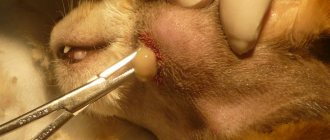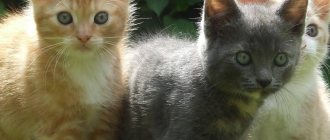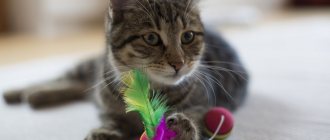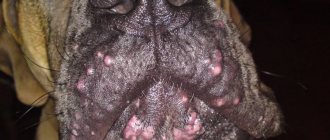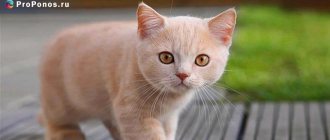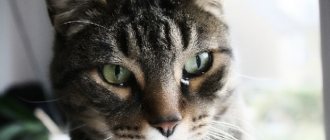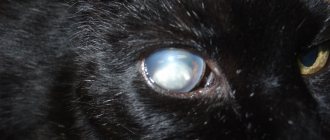Black spots in cats do not occur very often and may be the result of improper care. Sometimes such symptoms indicate disorders in the body that need to be identified as early as possible. A timely visit to a doctor will help determine the cause, and an integrated approach to treatment will eliminate the problem.
- 2 Causes and triggering factors
2.1 Why acne occurs in animals - video
- 4.1 Pharmacy and folk remedies
4.1.1 How to rid a cat of acne - video
What are blackheads in cats and why are they dangerous?
Blackheads (acne) are clogged sebaceous glands. The characteristic dark head occurs when sebum oxidizes. The appearance of such symptoms in an animal may indicate disturbances in the functioning of the body, the presence of parasites. Such a problem cannot be ignored.
Black spots can trigger the occurrence of furunculosis, which is characterized by a purulent process occurring in the inflamed sebaceous gland. This condition is dangerous for the pet’s health and can contribute to the spread of infection. Outdoor animals are most susceptible to acne, but comedones can also occur in indoor cats.
Blackheads in cats are caused by blocked sebaceous glands.
Malfunctions of the sebaceous glands also appear in completely healthy pets. If a cat likes to play outside, a small amount of dirt gets into the mouth and, mixing with sebum, clogs the duct. Most often, comedones are localized on the chin.
When acne occurs, the sebaceous gland becomes inflamed and expands. If the pore is not cleaned in time, bacteria will begin to multiply, which will cause the appearance of pus.
Inflammation of the sebaceous glands - acne
Having discovered black specks under the fur, the owner should know that this manifestation is associated with skin problems. As a result of neglect, this can lead to complications of the disease and long treatment.
© shutterstock
At first they look like black specks on the skin of the lower lip. Then the pimples mature and a white or black head appears, like human acne. If you comb out or squeeze out sores on a cat's chin, there is a high probability of introducing microbes, which will fester or bleed. In the advanced stage, the owner notices that the animal is behaving irritably, the fur is noticeably thinning and the chin is itchy.
The appearance of black specks on the chin can be caused by many reasons.:
- often manifests itself in domestic long-haired cats that have been improperly cared for, the feeding area is dirty and the water has rarely been changed;
- the appearance of black dots is also associated with animal stress (moving, fright, illness);
- may cause skin problems in parallel with other similar diseases;
- You may notice the appearance of acne in cats with a constantly dirty chin after eating, because this place is difficult to lick;
Black dots resembling grains on the lower jaw can appear in any cat, regardless of breed, age or gender.
Causes and provoking factors
The cause of the problem may be the individual characteristics of the body. At the same time, the owner needs to properly care for the pet, which will reduce the number of black spots. An additional factor in the occurrence of acne in the chin area is that this area has the least amount of hair. This makes it easier for bacteria to get into the pores.
Additional factors:
- poor nutrition;
- hormonal disorders;
- decreased immunity;
- liver diseases;
- pathologies of the sebaceous glands.
When the sebaceous gland is blocked, the excretory duct may become inflamed, which causes pain.
The problem can also occur on the hips, elbows and eyelids. Inflamed sebaceous glands can cause discomfort to the animal, causing pain. The skin in the acne area becomes red and sometimes swells slightly. Chronic intoxication, which occurs as a result of infection of the body with parasites, can provoke the appearance of black spots. At the same time, the waste products of helminths contribute to disruption of the functioning of various systems.
Attention! If a cat has acne, it is necessary to check the condition of the paraanal glands, which are located next to the anus. If they are inflamed, you should definitely consult a doctor. Otherwise, acne will appear again and again.
Why acne occurs in animals - video
How does acne appear in cats?
The disease goes through several stages in its development, but this does not always happen. Spontaneous stabilization of the process at one of the stages is possible, and cases of self-healing are also known.
Stages of the disease
Usually acne is characterized by several stages:
- The first stage of the disease is expressed by increased secretion of the sebaceous glands. The attention of the owner of a cat with light fur may be attracted by the persistent presence of fatty yellow spots on the pet’s chin, but in most cases the course is unnoticeable.
- In the second stage, comedones are formed. This happens because increased secretion of the sebaceous glands is accompanied by increased keratinization - the production of keratin protein, the main structural component of skin and wool. Protein masses prevent the normal emptying of the sebaceous gland, and as a result, the hair follicle into which the sebaceous gland duct flows becomes blocked by a mixture of glandular contents and protein. A comedon looks like a black dot, slightly protruding above the surface of the skin, and is often mistaken for pollution. Comedones are usually located on the chin, and somewhat less commonly on the skin of the lower lip. Typically, similar changes, if you part the fur, can be found at the base of the cat's tail.
- The third stage is characterized by inflammatory changes in the affected hair follicles, which are caused by bacterial flora. Folliculitis develops: first a red papule (bump) at the base of the hair, then a pustule (abscess) - the hair follicle dies and the hair will never grow again. After opening and drying of the pustules, crusts form. Experiencing pain and itching, the cat scratches the affected area, aggravating its infection. When the cat recovers, there are traces of superficial scarring in the affected area and areas of thinning of the coat.
Photo gallery: stages of acne in cats
Increased activity of the sebaceous glands with the formation of fatty yellow spots on the chin precedes the formation of comedones
In the second stage of acne, comedones form on the chin, areas of hyperpigmentation and redness are visible
At the third stage of acne, inflammatory changes occur in the follicles
In advanced cases, all elements of acne may be present on the skin: comedones, papules, pustules
Comedones look like a dirty spot on the chin
Possible complications and consequences
If the cat has not received treatment, then the severe course of the disease is characterized by the sequential merging of small foci of purulent inflammation into larger ones and the development of pyoderma (purulent skin infection), which is accompanied by:
- swelling;
- redness;
- purulent discharge;
- pain;
- increased body temperature;
- enlargement of regional lymph nodes.
When inflammation spreads from the follicle to the subcutaneous tissue, a boil forms. At this stage, surgical assistance is often required, consisting of opening, sanitation and drainage of foci of purulent inflammation. The general condition of the cat suffers markedly.
In ordinary cases, the consequences may be areas of alopecia (baldness) on the chin.
Features of acne in Sphynx and Persian cats
In Sphynx cats, a predisposition to acne is inherited. Mostly, completely hairless cats of blue, cream-blue and red colors are affected. Those individuals that have preserved delicate residual fur are less likely to get sick. Characterized by wide affected areas, covering the submandibular space, muzzle, neck, back area along the spine extending to the tail, as well as the stomach. When widespread, acne can lead to hyperpigmentation of the skin.
The most typical forms of acne for Sphynx cats are comedones and nodular cystic acne. In the latter form, deep inflammatory infiltrates are formed in the tissues, containing cavities filled with pus - cysts - which can unite and open onto the surface of the skin through the formation of fistulous tracts. The course of the disease is long, the favorite localization for this type of lesion is along the spine with continuation to the tail. Often in these places a typical “shell” is formed, consisting of layers of dead and keratinized epithelium and purulent exudate. After healing, persistent scar changes remain.
Veterinarians report that neutering improves acne in Sphynx cats.
In Persian and Himalayan cats, in addition to the typical course of acne, a rare disease occurs - idiopathic facial dermatitis. It occurs between six months and one and a half years. The cause of the disease is unknown. It manifests itself in the abundant secretion of a black waxy coating by the sebaceous glands, and the hair partially falls out. The areas of the chin and around the eyes are especially affected; deposits accumulate in the folds of skin on the face, as well as in the external auditory canal, causing bilateral otitis media.
Accumulations of dark discharge from the sebaceous glands on the cat’s face, partial loss of fur in the affected area - symptoms of facial idiopathic dermatitis
This disease has practically no cure. Fortunately, if hygienic care is taken and secondary infection is contained, it is only a cosmetic problem and does not affect the cat’s quality of life.
Photo gallery: acne in sphinxes
Comedones and papules are common in the lower lip area of a Sphynx cat.
Multiple comedones precede the nodular-cystic form of the disease
In the nodular-cystic form of acne, inflammatory infiltrates rise above the surface of the skin, hyperkeratosis (keratinization) of the skin of the tail is pronounced, traces of purulent discharge are visible
In severe forms of acne, a typical “shell” forms from dried purulent exudate and dead and keratinized skin cells
How to distinguish acne from other pathologies
It is important to be able to distinguish black dots from waste products of blood-sucking parasites and their larvae, as well as from droplets of dried blood that could appear as a result of trauma to the skin. Differentiating one condition from another is quite simple. You need to carefully try to detach the black lump. If it comes off easily from the skin and is dark brown in color, then it is dried blood.
Dried blood on a cat's chin looks like inflammation of the sebaceous glands
It is important to inspect the surface for scratches and small wounds. If the black dot has separated from the skin, but has a dense consistency and is difficult to press, then most likely these are waste products of ticks or fleas. Less commonly, these can be larvae of blood-sucking parasites. Acne is indicated by the inability to separate the blackhead from the skin. At the same time, it is as if soldered into the mouth of the sebaceous gland.
Flea larvae in cats can be confused with blackheads
If, in addition to acne, the animal has other symptoms, such as lethargy, appetite disturbances, diarrhea, then you should definitely consult a doctor.
Treatment for black spots on the chin in cats
Snot in a kitten, cat and cat: how to treat it
If black specks appear on your cat's chin, it is important to immediately seek qualified help. At a veterinary clinic, a specialist will determine what the disease is like and select the most effective treatment.
Most often, it is recommended to treat a cat with products intended for local treatment. For this purpose, special shampoos, tar soap or antiseptic solutions are used. For advanced diseases, medications and injections are prescribed and adjustments to the usual diet are recommended.
Improved pet care
A pet with this disease does not require special care. It will be enough to follow the recommendations given by the veterinarian. You can speed up the healing process by daily washing your cat's bowls from which the animal drinks and eats.
During the treatment process, it is very important to systematically remove dirt and food debris from your pet’s chin and gums. It is best to do this after every meal.
Treatment with antiseptics
If black crusts or dots appear on a cat’s face, experts recommend treating them with antiseptics. You can cure acne in a kitten or adult cat using tar soap. The affected area should be treated with it several times a day.
As for antiseptics, it is recommended to use hydrogen peroxide or chlorhexidine for pets. These drugs are used to treat the mouth and affected areas. 15 minutes after this, it is recommended to apply a cotton piece of fabric soaked in a hot decoction of calendula to the sore spot. Then the lesion should be wiped with salicylic acid, and then an ointment for acne in animals should be applied.
Antiseptic treatment of black spots on the chin of cats
Bathing with special shampoos
To help the animal get rid of black spots on the body, special antiseborrheic shampoos are used. They recommend washing the cat several times a day if pathology is observed throughout the body. If the disease manifests itself in certain areas, then it is enough to bathe the pet once a day.
When to go to the vet
It is almost impossible to determine on your own why a cat has black spots on its chin. If the disease begins to develop and the skin at the site of the lesion begins to go bald, then this is a sign that signals that you need to contact a veterinarian immediately.
Methods for eliminating comedones in pets
You can eliminate blackheads in a cat using an integrated approach to the problem. To do this, you should normalize the pet’s diet, eliminating everything harmful to its body, and also carry out deworming, that is, get rid of worms using one of the specialized drugs: Milbemax, Drontal, Dirofen, etc. You can also use topical pharmaceuticals for treatment. applications. Traditional methods will help complement therapy and make it more effective.
To eliminate acne, first of all, it is necessary to deworm your pet using the drug Milbemax or other similar products.
You should start eliminating comedones only after consulting a doctor, since the cause of the pathology can be serious disturbances in the functioning of the body.
Pharmacy and folk remedies
To eliminate acne in adult animals, the drug Percutan can be used. This medication has antibacterial properties, due to which it prevents the proliferation of pathogenic microflora and eliminates the inflammatory process. The medicine is available in the form of a solution for external use. It should be applied with a cotton swab 2 times a day to the affected areas of the skin. The course of treatment should be from 4 to 10 days.
Percutan has an antibacterial effect
Also, the area affected by blackheads can be treated with calendula tincture, which has anti-inflammatory and antiseptic properties. This product can regulate the functioning of the sebaceous glands, reducing fat production. The tincture should be used once a day. The most convenient way to apply the liquid is with a cotton swab. The treatment course should not exceed 4–5 days, since the tincture contains alcohol, which can dry out the skin.
Calendula tincture eliminates inflammation
For treatment, you can also use Furacilin solution, which is active against a wide range of microorganisms. At the same time, bacteria and inflammation are eliminated, due to which comedones gradually disappear. 1 tablet of Furacilin must be dissolved in 1 glass of warm water. Treat the affected area with the resulting liquid 3 times a day for a week.
Furacilin produces an antiseptic effect
It is also possible to use retinol (vitamin A) in the form of ointments and creams. These products include: Differin, Clenzit and others. These drugs should be used with caution, as they can cause severe skin irritation. Apply the ointment with a cotton swab in a thin layer every other day for a week. If your pet experiences itching and redness of the skin, then it is recommended to abandon this method of treatment.
Clensite helps eliminate acne, but can cause irritation
Another effective remedy for eliminating the problem is a solution of methylene blue, which can be purchased at a pharmacy. It soothes the skin by eliminating overactive sebaceous glands. You can treat the affected areas with this product no more than once a day for 3-4 days. If during this time the blackheads have not disappeared, then it is recommended to use another method, since methylene blue slightly dries out the skin.
Methylene blue relieves acne and heals skin
To get rid of comedones, you can also use Chlorhexidine. It eliminates bacteria and excess sebum, while blackheads decrease in size and then completely disappear. The solution should be used no longer than 4–5 days, because it can dry out the epidermis. Wipe the skin with this product 2 times a day using a cotton pad. It is advisable to do this after the pet has eaten.
Chlorhexidine should not be used for more than 5 days
For treatment, you can also use Elite shampoo, which is designed specifically for the treatment and prevention of skin diseases in cats and dogs. This product contains chlorhexidine, plantain and celandine extract, glycerin and provitamin B with allantoin. The shampoo is easily applied to the coat, foams and is washed off with warm water. After just a few uses, acne will disappear.
Elite shampoo is designed specifically for the treatment of skin diseases
In advanced cases, when a secondary infection occurs and suppuration occurs, it is recommended to use tetracycline ointment, which is active against a wide range of pathogenic microorganisms. This remedy should be applied to the site of inflammation 2 times a day. The course of treatment varies from 7 to 10 days. If at the end of therapy there is no result, then you should definitely consult a doctor.
Tetracycline ointment is active against a wide range of bacteria
An excellent folk remedy that helps solve this problem is tar soap. You can use it without fear. This remedy rarely causes allergic reactions, but it eliminates inflammation, fungal and bacterial infections, and also promotes tissue regeneration. Tar soap should be applied to the affected area once a day for a week. In this case, the skin should be pre-moistened with water. After application, you need to wait 5 minutes and then rinse off the product.
Tar soap does not cause allergic reactions
A good effect is produced by chamomile infusion, which eliminates inflammation and skin itching. You will need 1 tbsp. l. dry raw materials, which needs to be poured with a glass of boiling water and left for 1 hour. Then filter the liquid and apply it to the acne area 4 times a day using a cotton pad. The course of treatment is from 10 to 14 days.
Chamomile infusion helps you get rid of blackheads faster
Attention! Under no circumstances should you squeeze your pet's acne. Otherwise, you can provoke increased inflammation and the addition of infection, which will lead to the occurrence of furunculosis.
A friend has a white cat that has black spots on its chin. No one would have thought that animals could also have such a problem. A friend was scared at first because she thought it was not acne, but some kind of serious disease, so she immediately took her pet to the doctor. After examination, the vet said that these were just black dots. Prescribed Chlorhexidine and medicated shampoo. We managed to get rid of the problem in less than a week. Additionally, the doctor recommended paying attention to your pet’s diet.
How to rid a cat of acne - video
Diet food
In order to speed up your pet's recovery, it is recommended to normalize its diet. It is necessary to exclude everything fatty and fried from the cat’s menu, as well as milk and sour cream. It is best to feed your pet a specialized product suitable for a specific breed. In this case, preference should be given not only to dry options, but also to include in the animal’s menu boiled chicken and fish, carrots (which can be mixed with the main food), eggs, cottage cheese, as well as grass, which can be purchased at a veterinary store.
Boiled chicken should be included in your cat's menu
To prevent the problem from occurring regularly, it is important to avoid cheap food that contains a large amount of flavorings, preservatives, and salt, which increases the risk of urolithiasis. This product is very harmful to the pet's immune system. It is recommended to purchase food from the Royal Canin, Purina and other series.
Royal Canin - a line of quality cat food
It is also important that clean boiled water is always available to your pet. At the same time, for watering and feeding, it is better to give preference to iron or glass bowls, since plastic ones emit toxic substances that are harmful to the animal’s body. To strengthen the immune system and to reduce the risk of recurrence of acne, you can include special feed additives containing vitamins (Beaphar and others) in the menu.
It is better to use iron bowls to feed your pet.
To prevent malfunctions in the cat’s body, you should never give your pet bones, raw fish, sweets, as well as onions and garlic.
Can a kitten develop blackheads?
Comedones in kittens occur in isolated cases, since the body of most pets works smoothly up to 6 months. However, if such a problem does arise, then only non-aggressive means can be used for treatment. When eliminating black spots in kittens, you can use chamomile infusion, tar soap, and Furacilin. These products should be used once a day. The exception is chamomile infusion. It can be used 3-4 times a day. The course of treatment is often from 5 to 7 days.
Acne in kittens occurs in isolated cases
The occurrence of acne in kittens should be alarming, as this may be a sign of gastrointestinal dysfunction. It is important to monitor your pet's stool and appetite. If there are no alarming symptoms, then only local remedies can be used for treatment.
Symptoms of blackheads on the chin
The most pronounced symptom is redness of the skin.
Comedones squeezed out by the cat's owner.
Next, small acne appears, called comedones , they look like a cone with a black top, and gradually increase in size. The tops of the cones may also be white. This happens because the plug is deep inside, without access to air.
A pile of comedones looks like flakes of dirt on an animal's fur. Usually the cat owner thinks that it is dirt similar to soil.
The lower jaw swells. In advanced or severe forms of the disease, pustules and skin nodules appear on the affected area. Pain and itching appear. The cat is worried, shows nervousness, aggression, and scratches the chin area. On the inflamed area, purulent or bloody crusts are released. The fur falls out.
Establishing diagnosis
It is not possible to make a diagnosis on your own.
The exact clinical picture will be determined by a veterinarian at the clinic. After a visual examination, the doctor prescribes a laboratory examination. The pet's skin is scraped, a test is taken to detect a fungal infection, and less often a biopsy is performed.
Allergies have similar symptoms to ACNE.
The necessary studies are carried out to exclude similar diseases: demodicosis , dermatophytosis, allergies, eosinophilic granuloma, scabies .
Treatment
Treatment is carried out comprehensively, including local treatment, oral administration, injections, and diet. For local processing use:
- tar soap;
- medicated shampoo against seborrhea;
- tar shampoo;
- antiseptic solutions - chlorhexidine, miramistin;
- cotton-gauze bandage with calendula tincture;
- percutane.
A jar of hydrogen peroxide.
hydrogen peroxide, salicylic alcohol, and iodine is recommended for treatment with caution . Percutan is prescribed twice a day until symptoms disappear completely. For purulent and bloody crusts, the use of external antibiotics - mupirocin, bactroban - is indicated.
Antibiotics are prescribed if there is a secondary infection. Severe inflammation is treated with a course of corticosteroids - prednisolone. It is necessary for treatment to prescribe vitamin supplements in the form of omega-3 and omega-6 acids. The animal is kept on a low-fat diet.
A neglected case.
Additionally, you can use a solution of chlorophyllipt or clotrimazole . Apply directly to acne. After treatment with the above solutions, apply sulfur ointment without rubbing. Treatment at home requires compliance with some precautionary rules. Under no circumstances should pimples be squeezed; they must go through the process of maturation and opening on their own.
It is not recommended to brush the affected area. It is forbidden to treat the entire surface - only dot strokes.
Frequent wetting will cause the skin to dry out and, as a result, cause a chemical burn. Use antiseptics such as alcohol, iodine, brilliant green with extreme caution. Frequent use will lead to a larger area of localization of the rash.
Zelenka can be replaced with an aqueous solution of methylene blue, which will remove irritation. Be sure to apply local preparations in a thin layer. In some cases it is necessary to interrupt treatment. Such cases include situations in which skin irritation increases. Even with positive results of treatment, you should immediately interrupt the therapy and allow the irritation to subside, ensuring all measures for the healing of the epidermis.
When the area affected by acne only increases and does not decrease. It is worth stopping intensive use of drugs for several days. After some time, resume treatment, but use other medications.
Traditional medicine against blackheads
The effect in the treatment of acne is provided by folk remedies.
Tincture of calendula.
A decoction of chamomile flower with calendula and furatsilin helps well. To do this, you need to mix the decoction with two tablets of furatsilin, crushed into powder, and treat the inflamed area twice a day.
Celandine grass is used for lotions. You need to take four tablespoons of chopped herbs, six glasses of water, and boil for five minutes. Cool, strain. Lubricate the sore spot and make a lotion.
Fresh pumpkin is useful to use. You can apply a freshly cut piece to the affected area three times a day and lubricate it. Keep it for 3-5 minutes.
One teaspoon of crushed yarrow herb is poured into a glass of water and brewed. The decoction, strained and cooled to room temperature, is used to treat the area affected by the rash.
Prevention measures
What measures to take to prevent blackheads from appearing again:
- Feed your pet correctly, giving preference only to high-quality and approved products.
- Do not give your animal strong medications without a doctor’s prescription.
- Deworm your pet once every 3 months.
- Monitor the functioning of the cat’s immune system by periodically giving your pet vitamins.
- If any malfunctions occur in the gastrointestinal tract, contact a veterinarian and do not delay treatment.
- Try to protect the animal from stress.
- If the animal often goes outside, it is recommended to bathe it once a month, and also wipe its paws regularly.
- Check your cat for fleas once a week. To do this, you should spread the fur in the area of the withers, belly and hips. If larvae are found, it is imperative to select them or use special means.
- If your cat always has food residues drying out on his chin after eating, it is recommended to wipe this area with wet wipes that do not contain alcohol or harmful fragrances.
If the problem arises from time to time and is an individual feature of the pet’s body, then fresh pumpkin juice can be used for prevention. They should wipe the areas where acne most often appears once a day every few days.
The appearance of blackheads in pets does not affect their general well-being if the provoking factor is harmless. However, the occurrence of acne can often be accompanied by unpleasant sensations. For this reason, it is recommended to begin treatment immediately after identifying the problem. Preventive measures will help prevent the recurrence of the pathology.
How to prevent the appearance of black specks in cats and kittens
Make sure that the bowl of water is changed every day, and food is not left out for more than a day. Use good quality containers (ceramics, metal). Over time, microbes appear in plastic dishes, which are transferred with food to the fur and into the cat’s body. This leads to various diseases, such as acne on the lower lip of cats. For woolly animals, after liquid and greasy food, it is necessary to wipe the dirty fur with a napkin.
Self-medication is strictly prohibited. Try to remove black particles from the cat. Use acne or pimple treatments for humans. This may cause an allergic reaction or irritation.
Symptoms of fungus in cats
Since primary symptoms often go unnoticed, in practice we often have to deal with already complicated (secondary bacterial infections) lichens. Alas, in such situations, animals not only have bald patches on the chin and other parts of the body: everything is much more serious.
Extensive foci of inflammation and scabs appear on the skin, and abundant exudate is visible from the ulcerated areas. The remaining fur becomes matted and turns into “icicles”, being glued together by the exudate. It is possible to develop infections of the upper respiratory tract and oral cavity (also fungal or secondary bacterial).
Please note that it is strongly recommended to cut sick pets, as there may be even more fungal lesions under the fur.
What are cat acne?
A cat's skin is covered with sebaceous glands. When exposed to unfavorable factors, the pores become clogged. This is a long process that lasts for years without obvious symptoms. The plugs are made up of subcutaneous fat. During the oxidation process, clogged pores turn black. Acne occurs due to excessive production of sebum by the sebaceous gland. With prolonged absence of treatment, an inflammatory process develops. The animal feels discomfort. The quality of life and appearance of the pet deteriorates.
If the sebaceous glands become inflamed, acne appears in cats.
Most often, rashes appear on the chin, lower lip and skin around the ears. In advanced cases, acne covers the thighs, stomach, withers and the area at the base of the tail. Cats of all ages and breeds are susceptible to this pathology. The disease develops slowly and begins to cause discomfort in the later stages. Acne in a cat can be cured if you consult a veterinarian in a timely manner.
Acne appears for various reasons. Heredity plays an important role. Sometimes cats have a genetic predisposition to acne. Increased activity of the sebaceous glands from birth is an individual feature of the animal. The normal condition of the skin is maintained with the help of properly selected hygiene products.
If your cat has a pimple, this may indicate a lack of proper care. Some animals are prone to excessive earwax production. The sebaceous glands become clogged and cause discomfort. As they become dirty, owners should clean their pet’s ears with a special gel or spray using cotton wool.
You cannot carry out hygiene procedures too often. The presence of black dots may indicate that the protective layer from the cat's skin is being washed away. The sebaceous glands intensively secrete secretions to replenish the missing amount of sebum.
Acne on a cat's chin is a consequence of reduced immunity.
If an animal does not receive the necessary vitamins, minerals and trace elements, then the body fails. Veterinarians advise using high-quality super-premium food to feed your pet. Such food is balanced and helps strengthen the immune system. It is not advisable to feed your pet from plastic bowls, as microbes actively multiply in them. It is better to use iron, glass or ceramic dishes.
